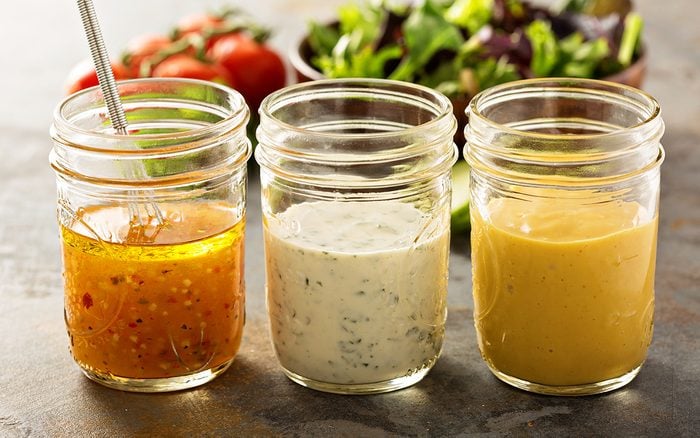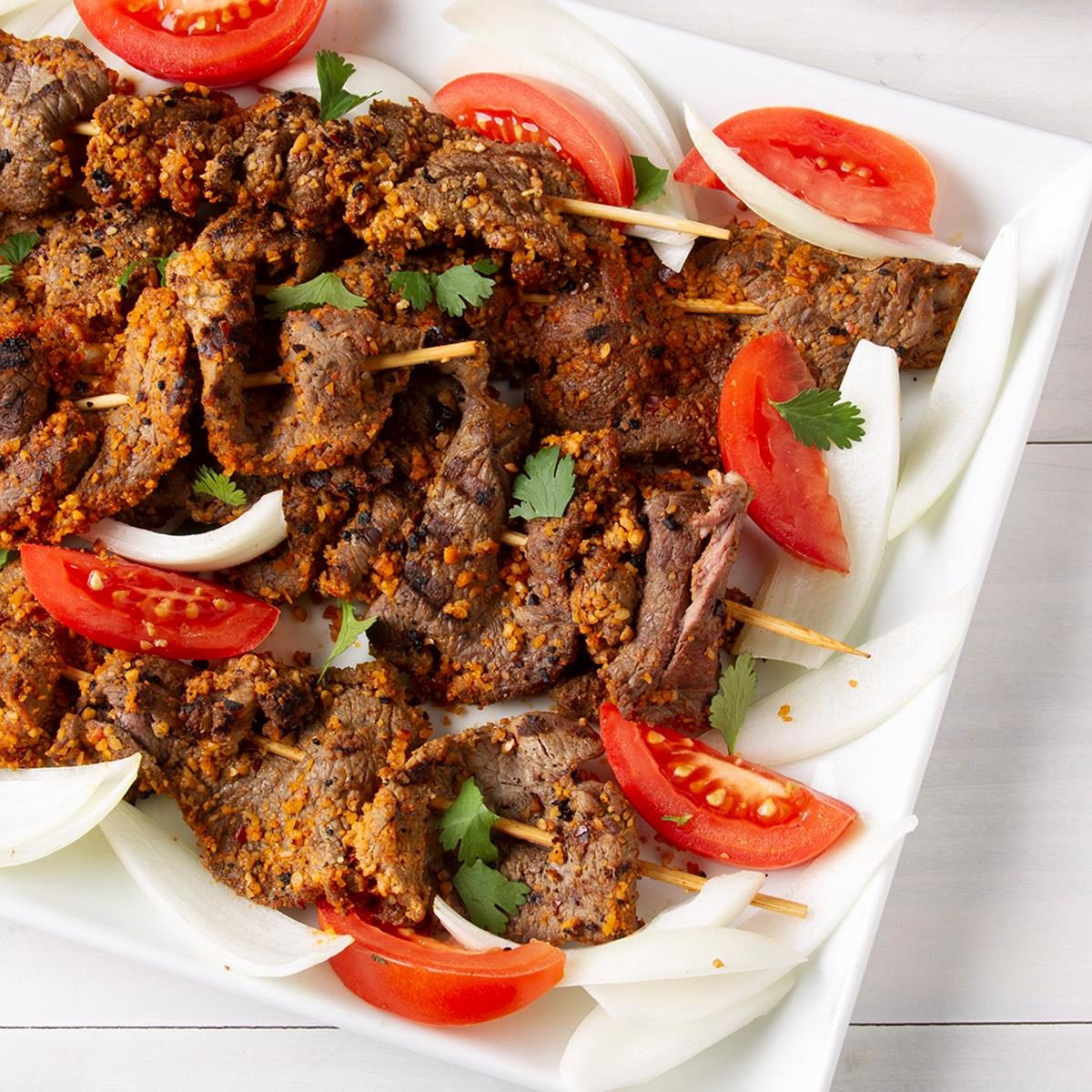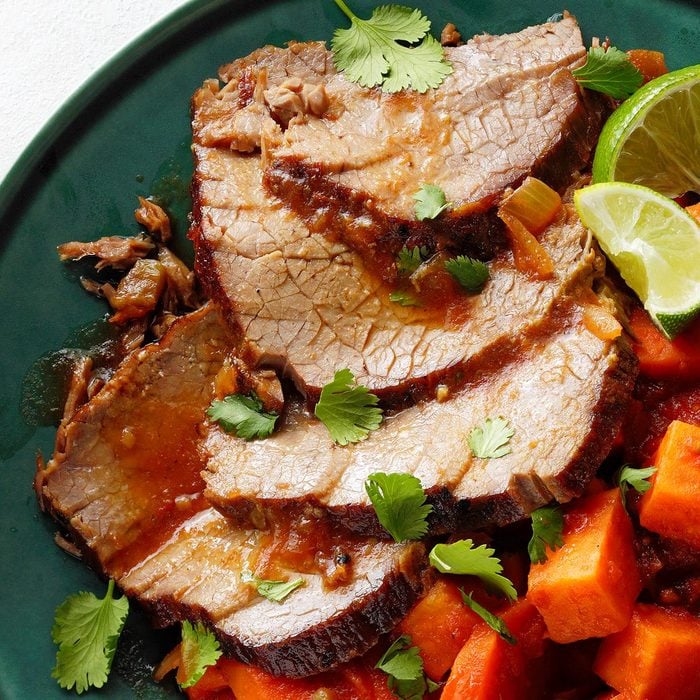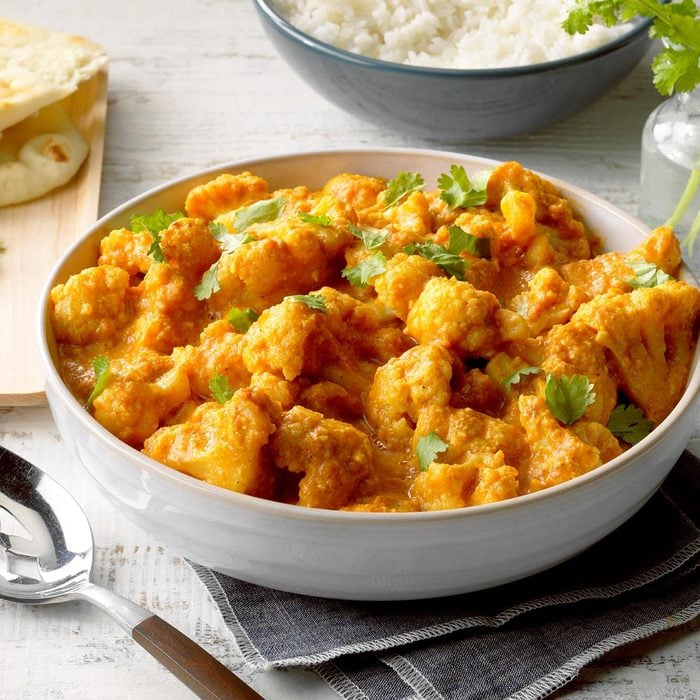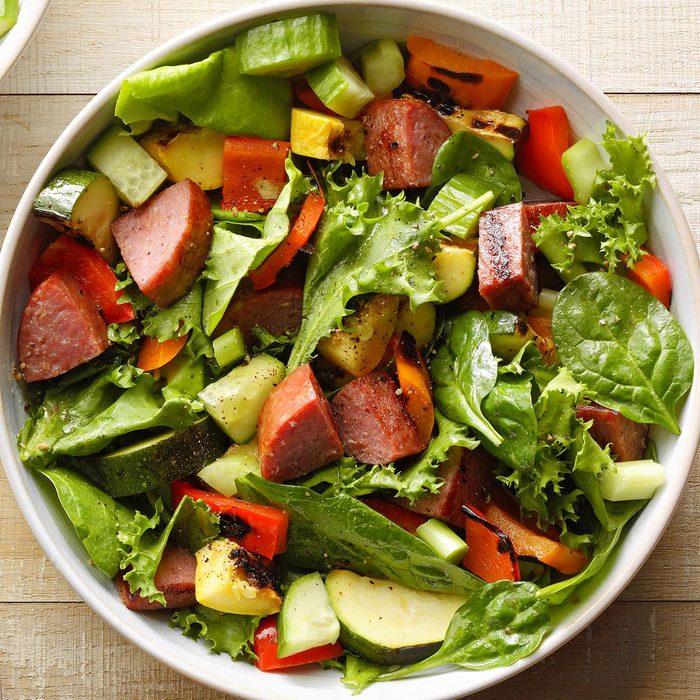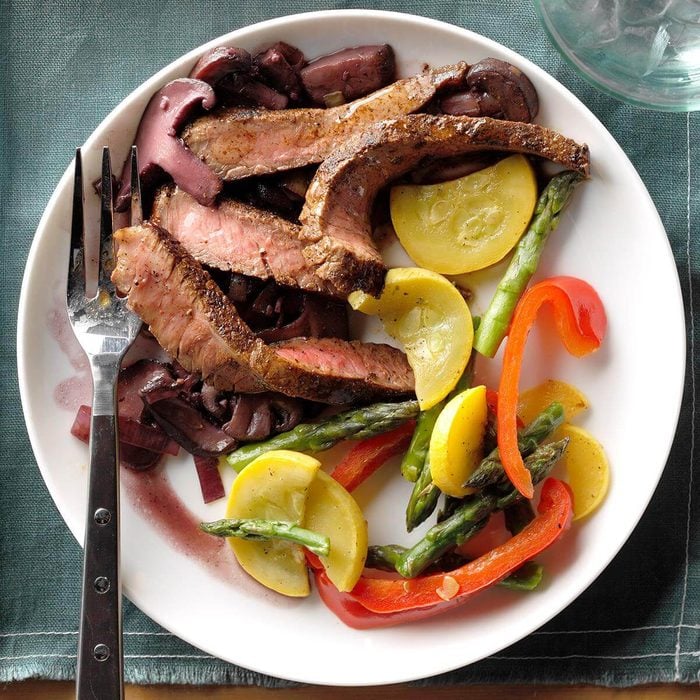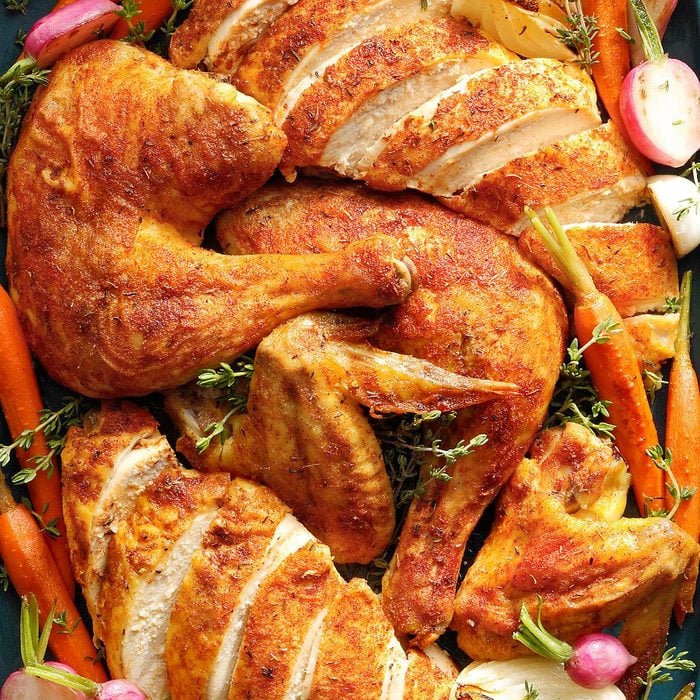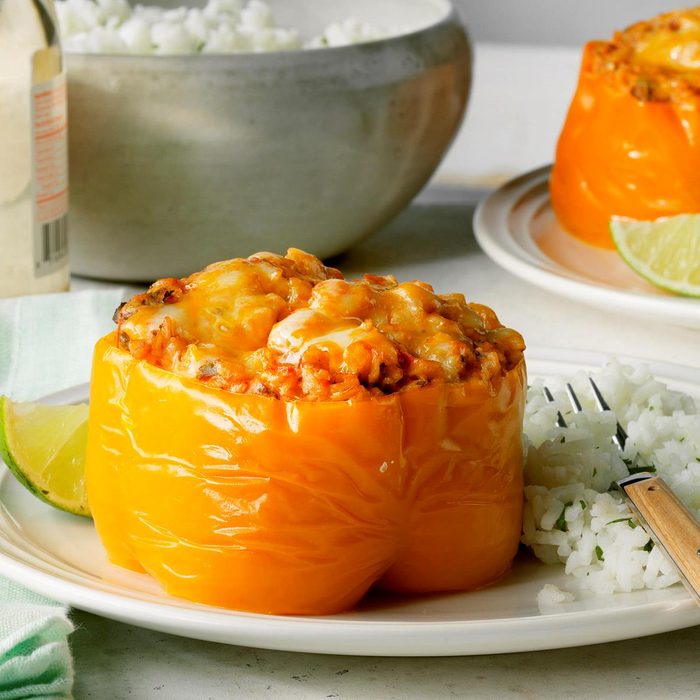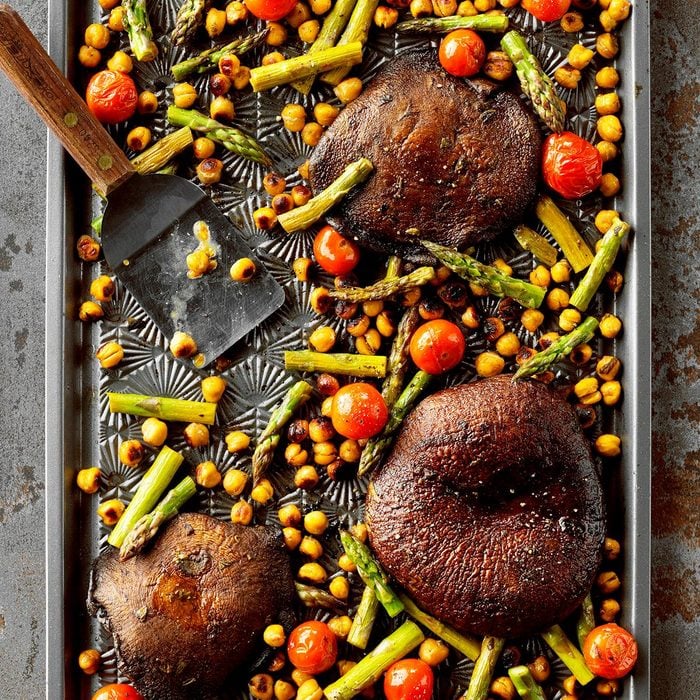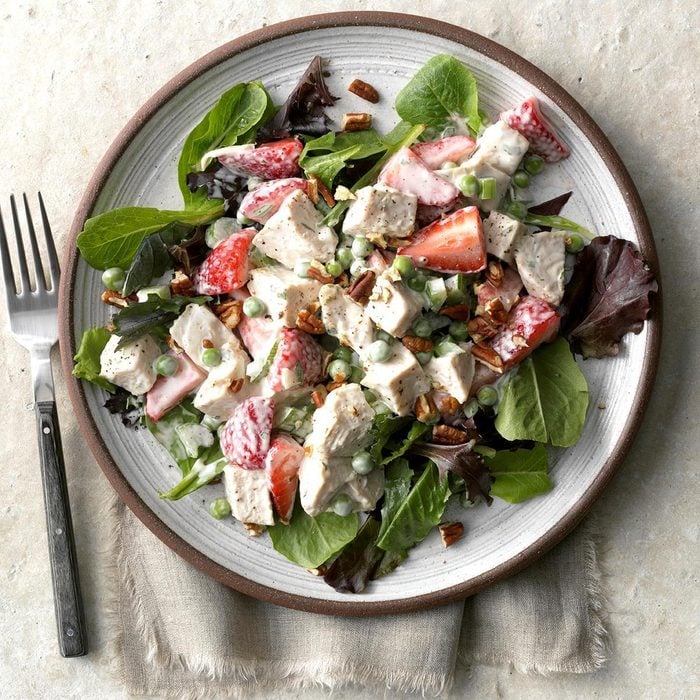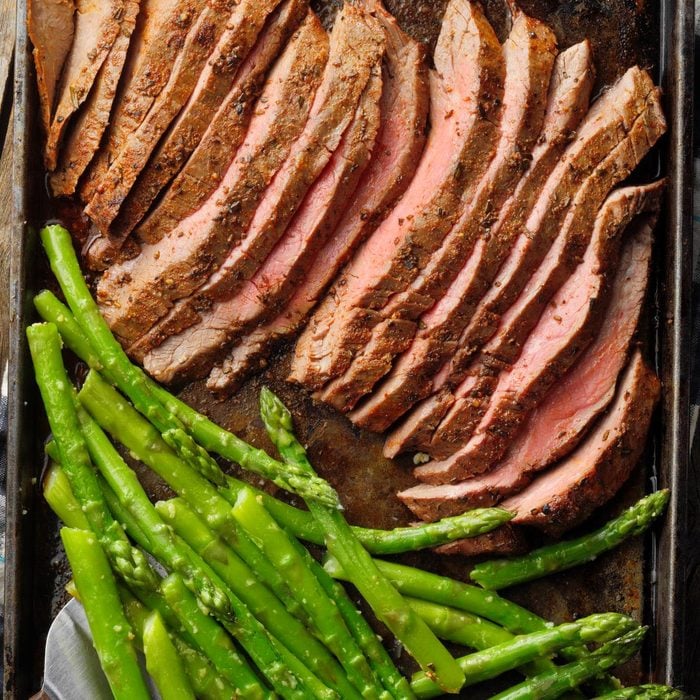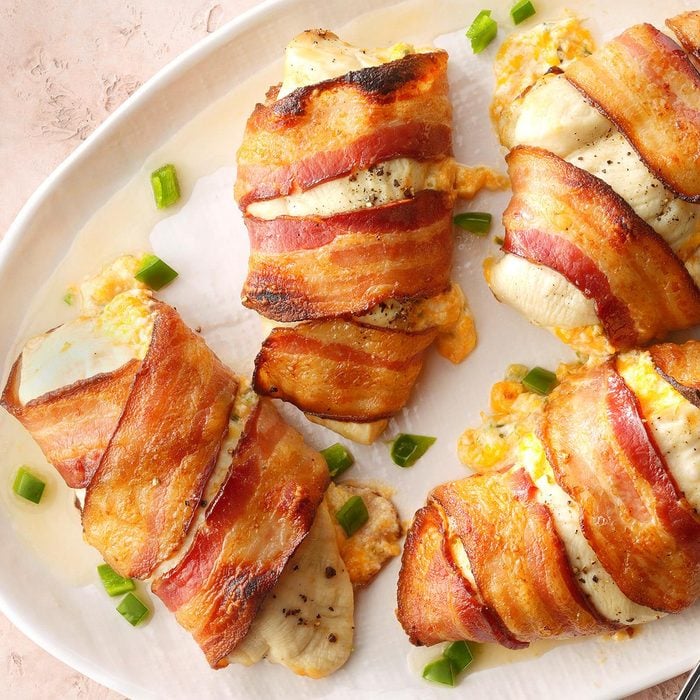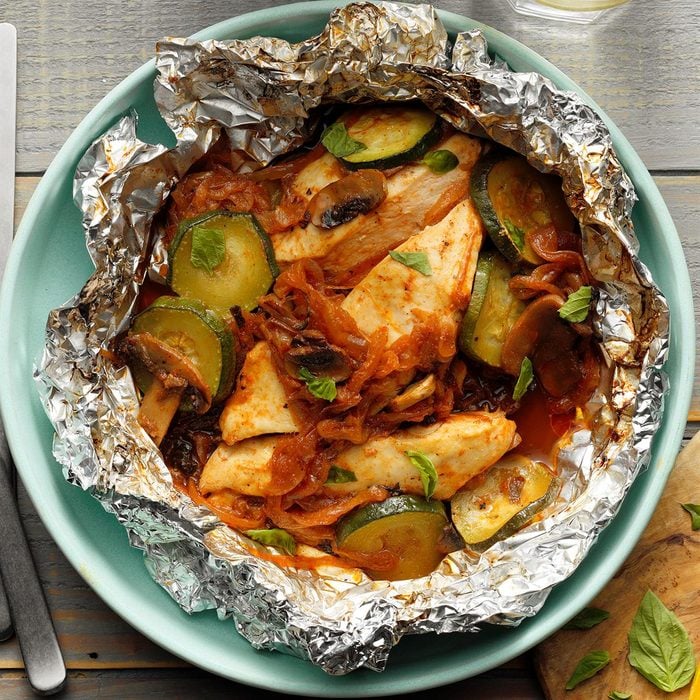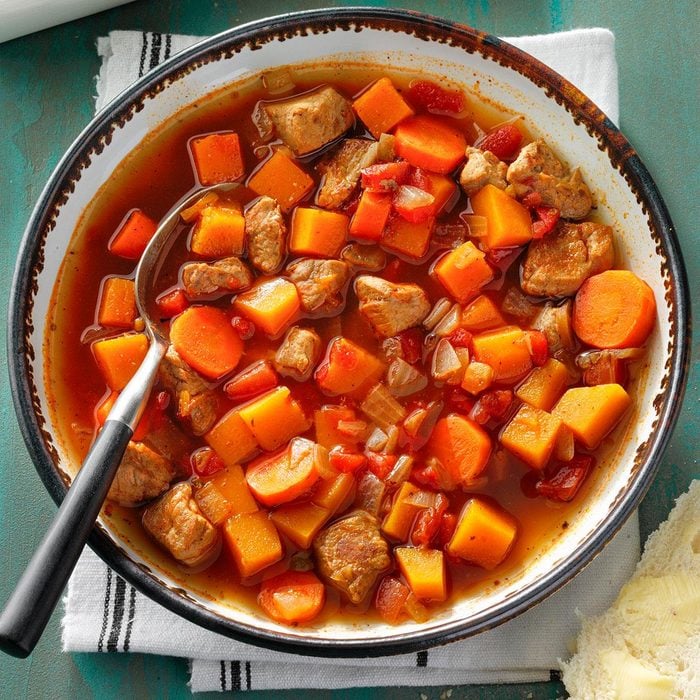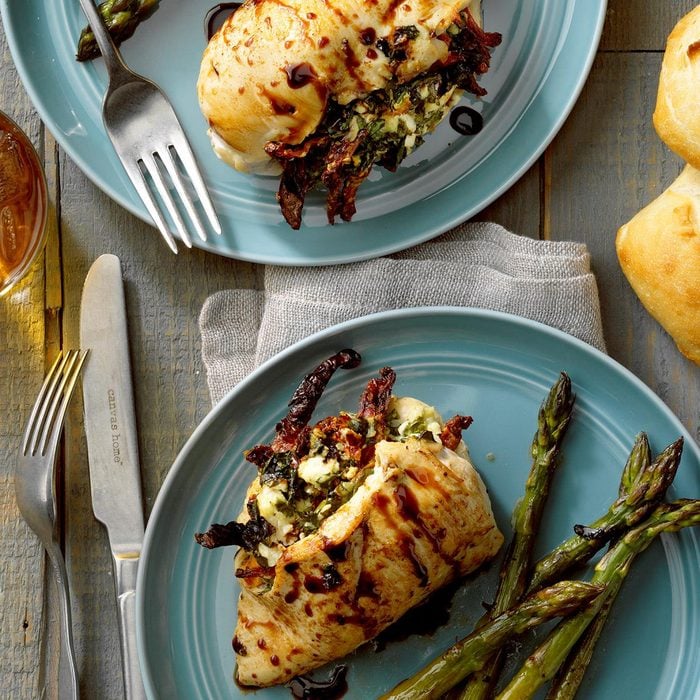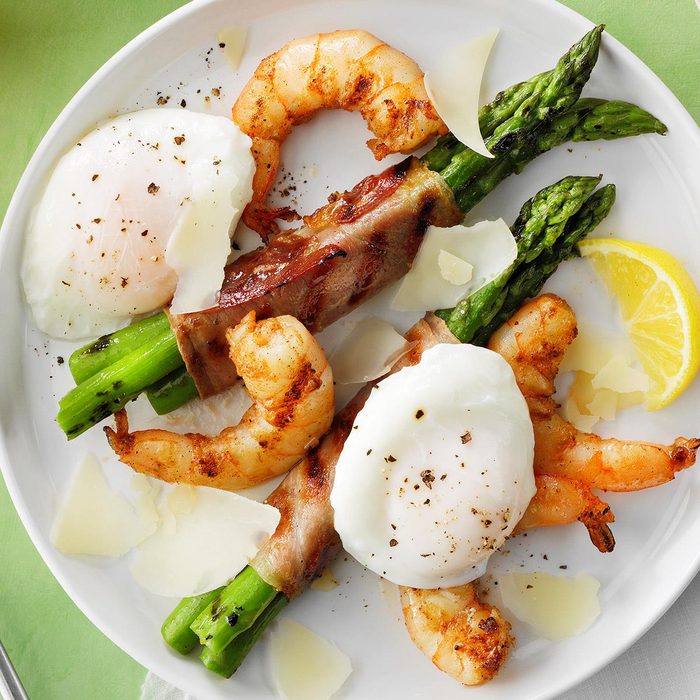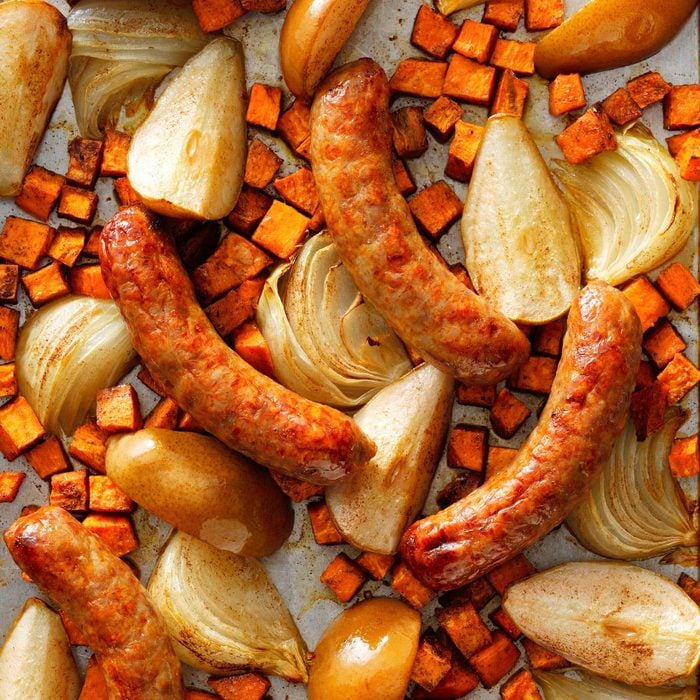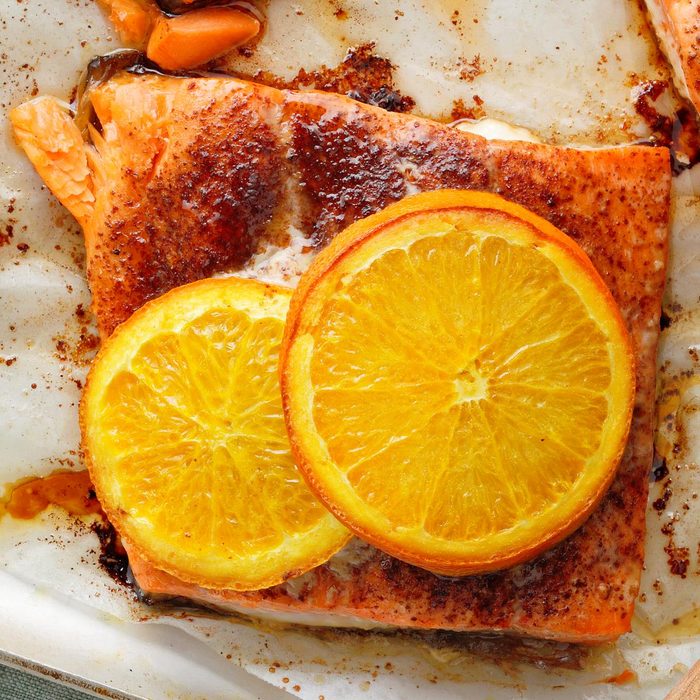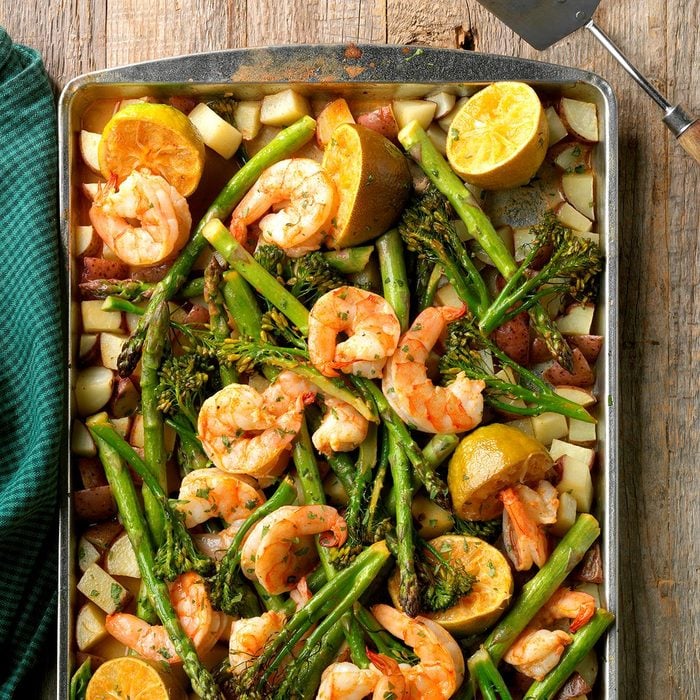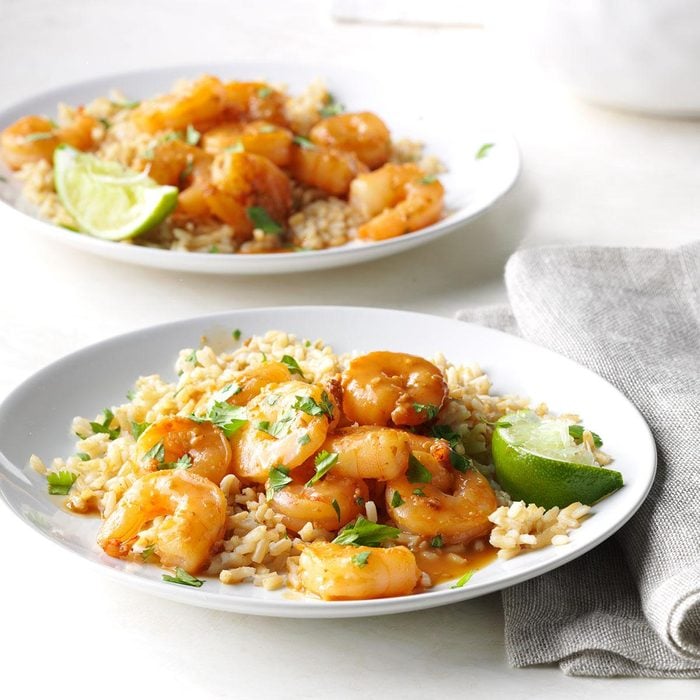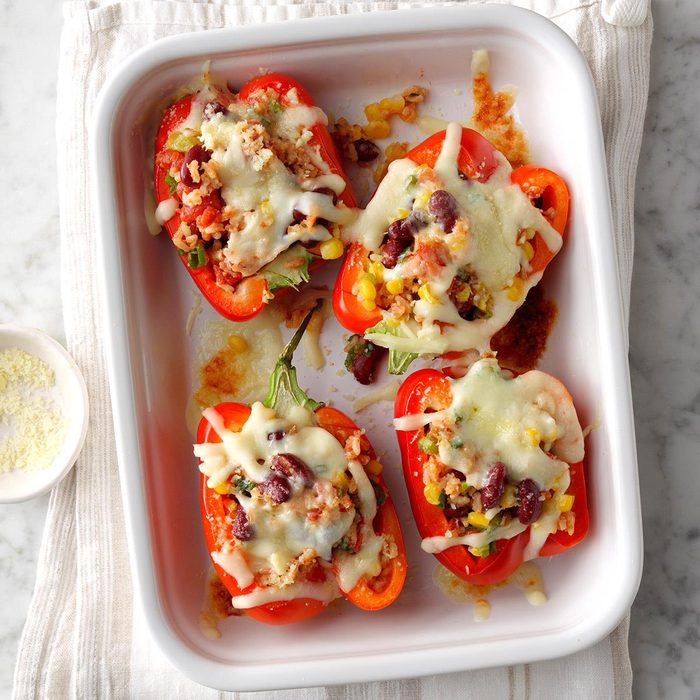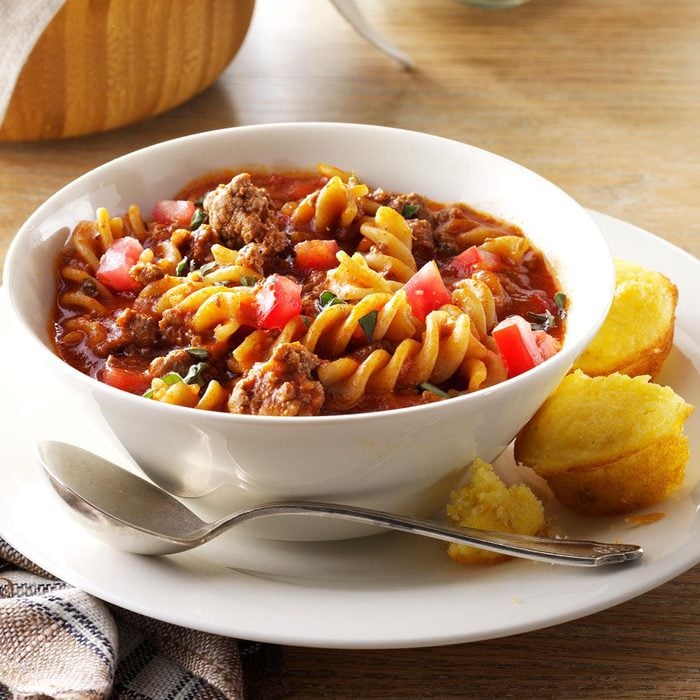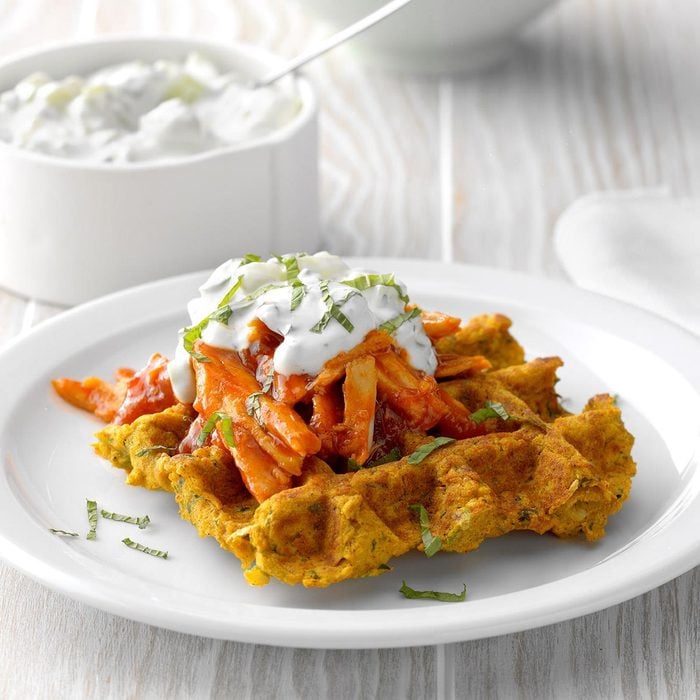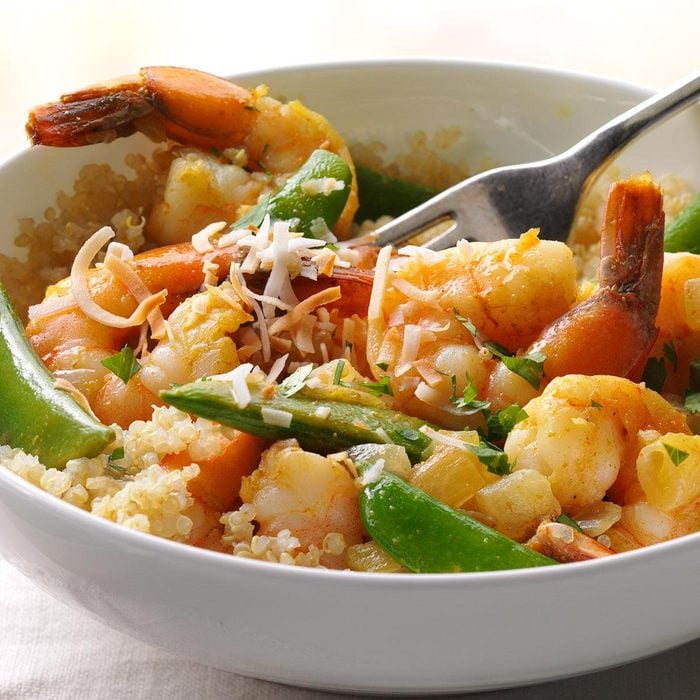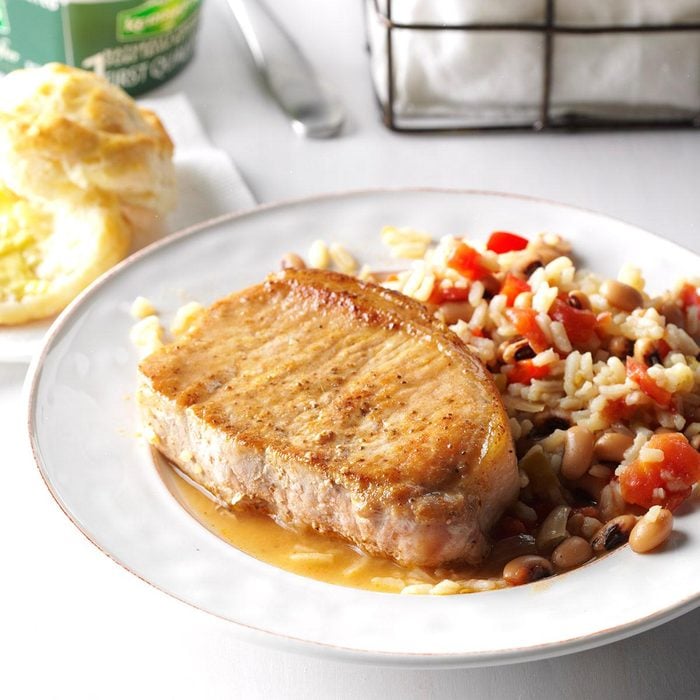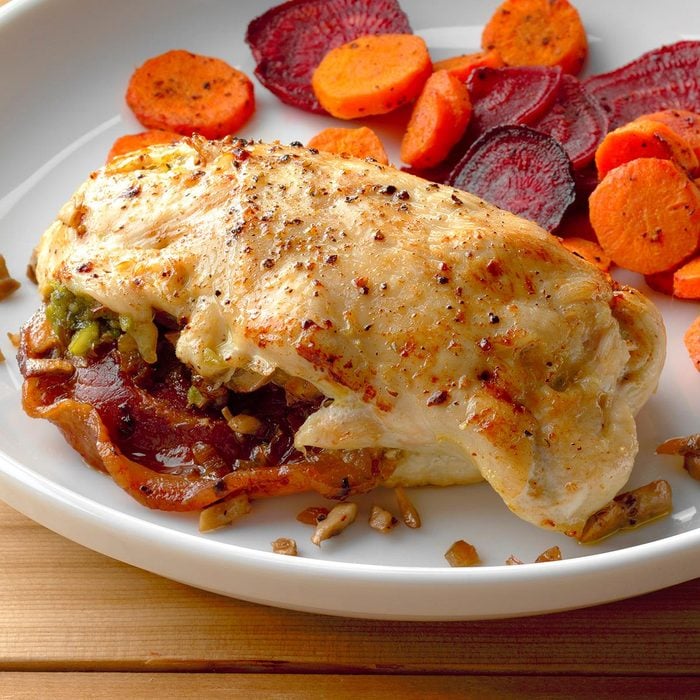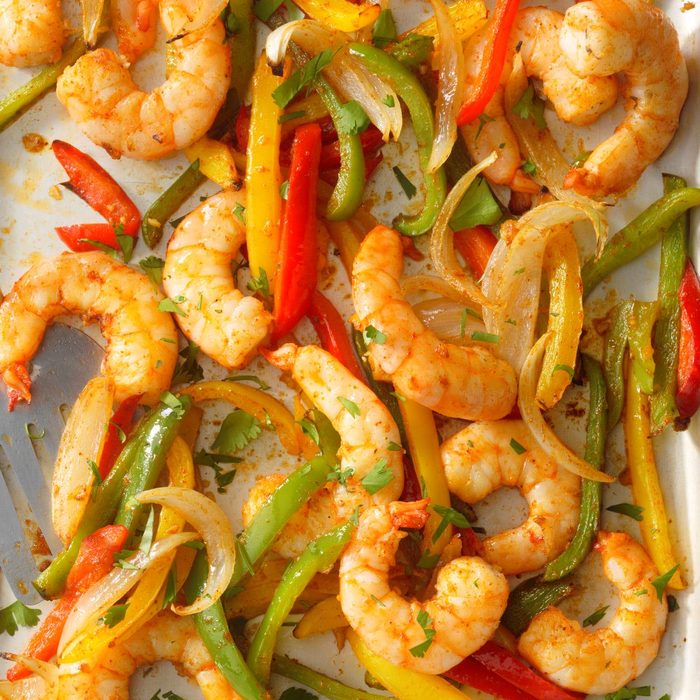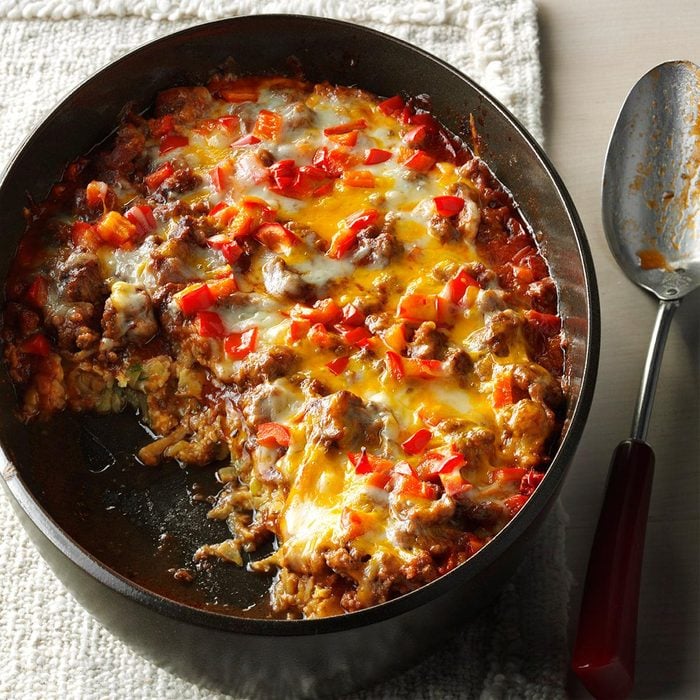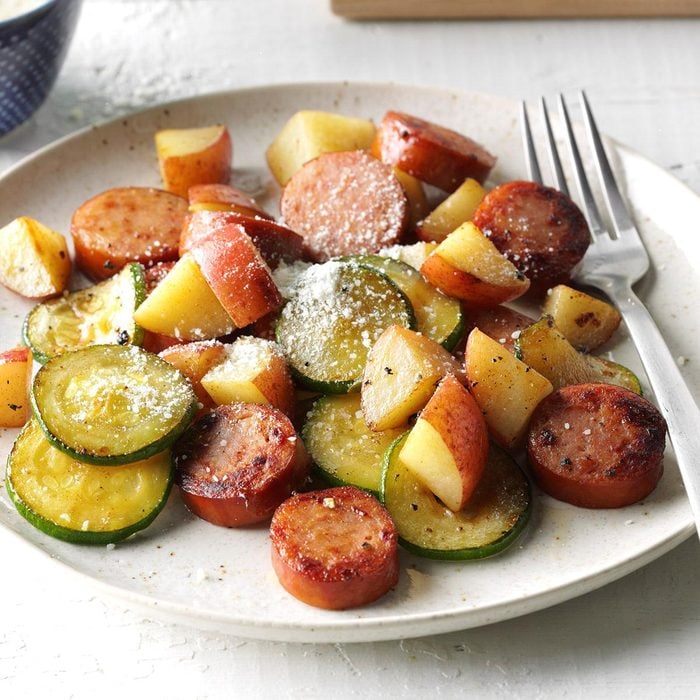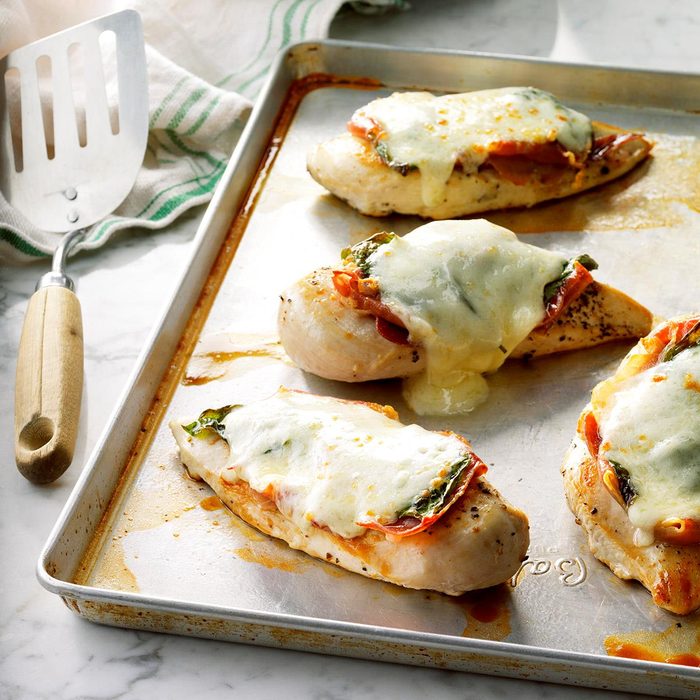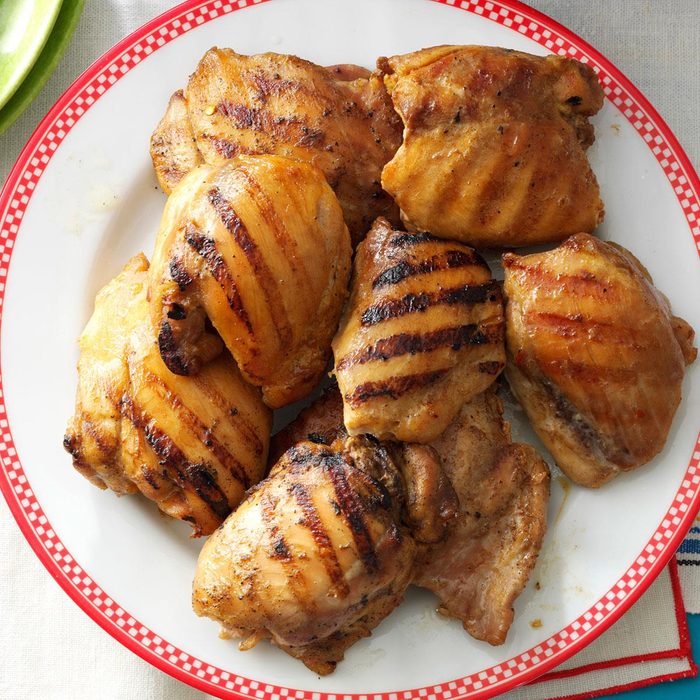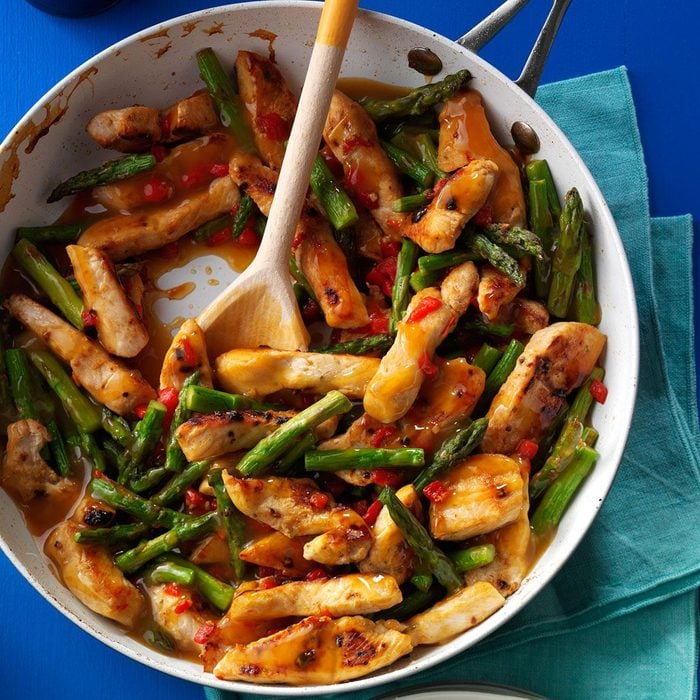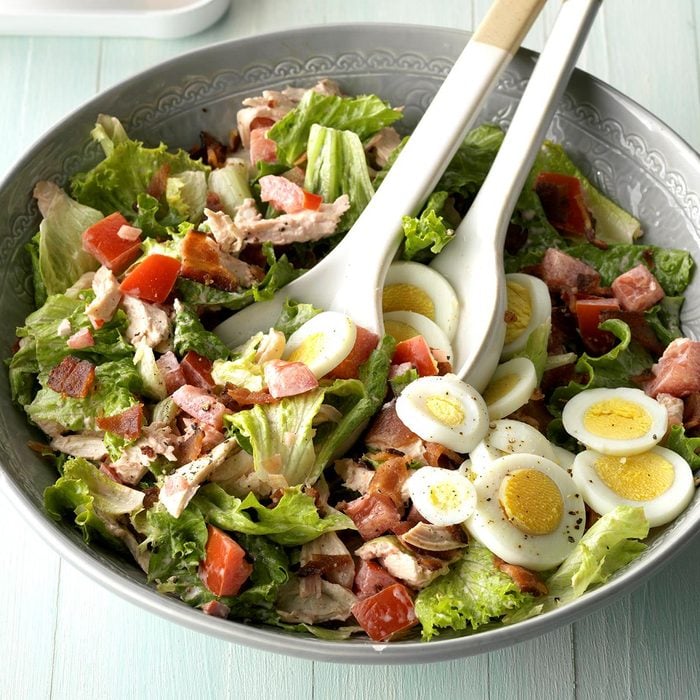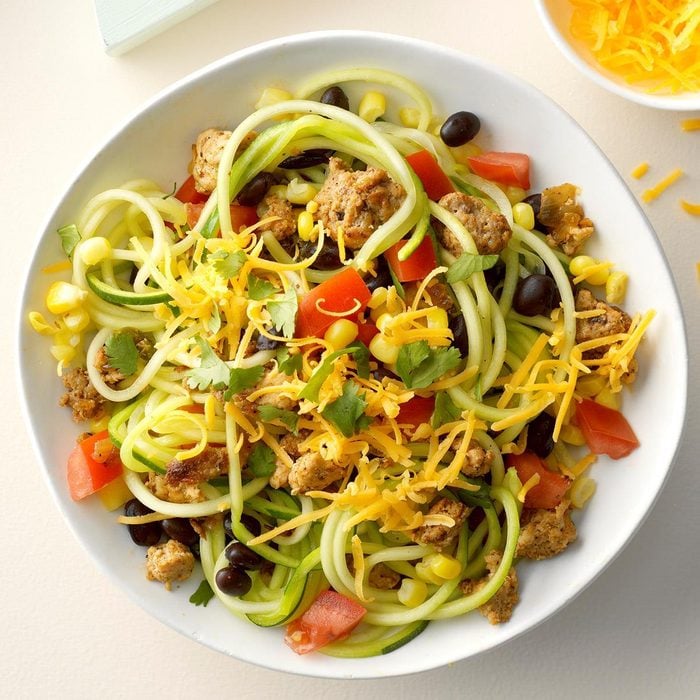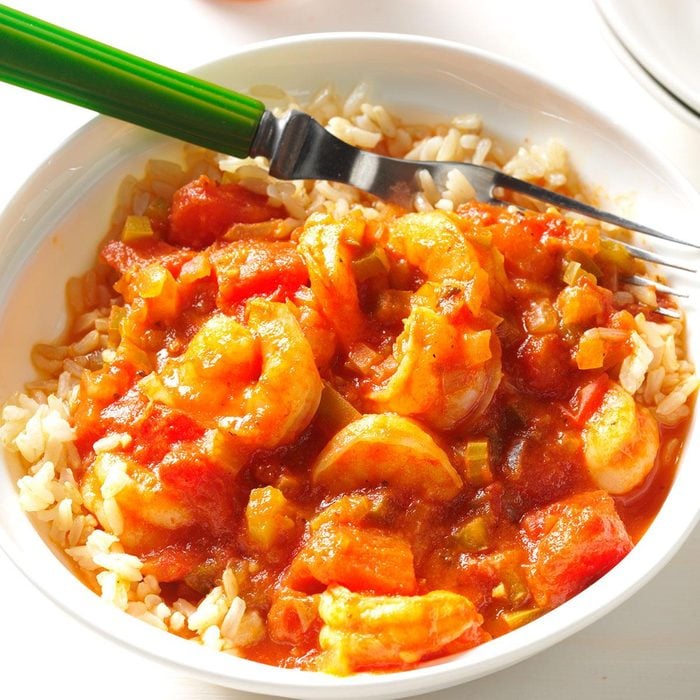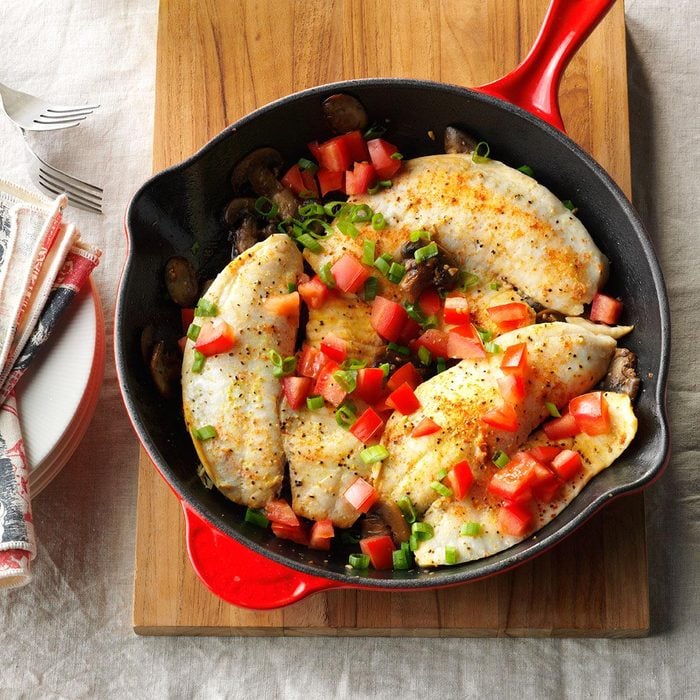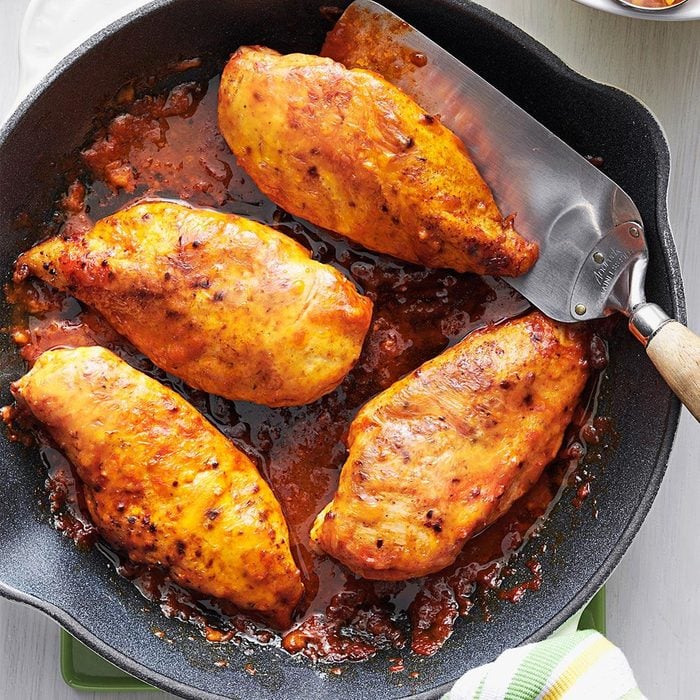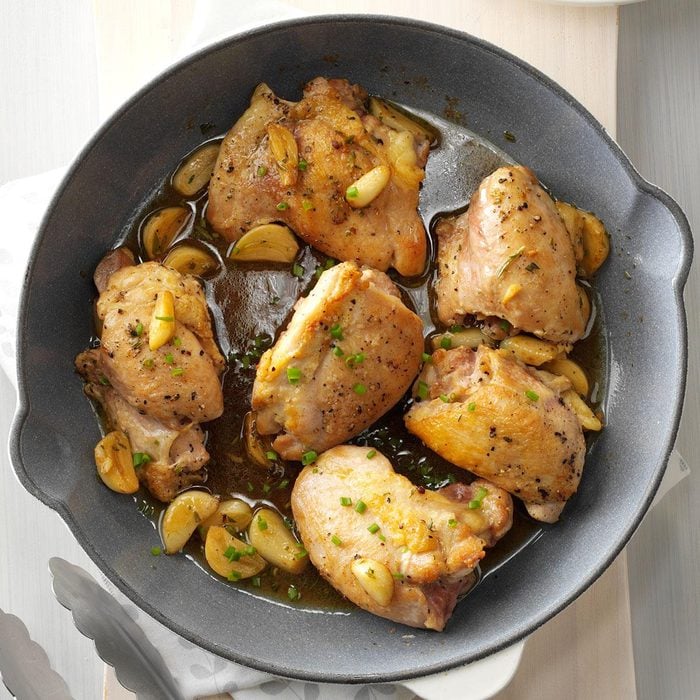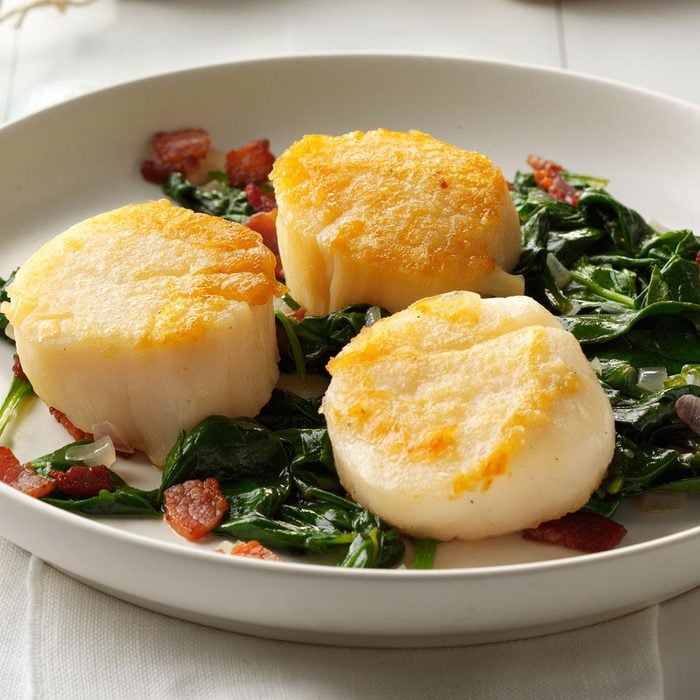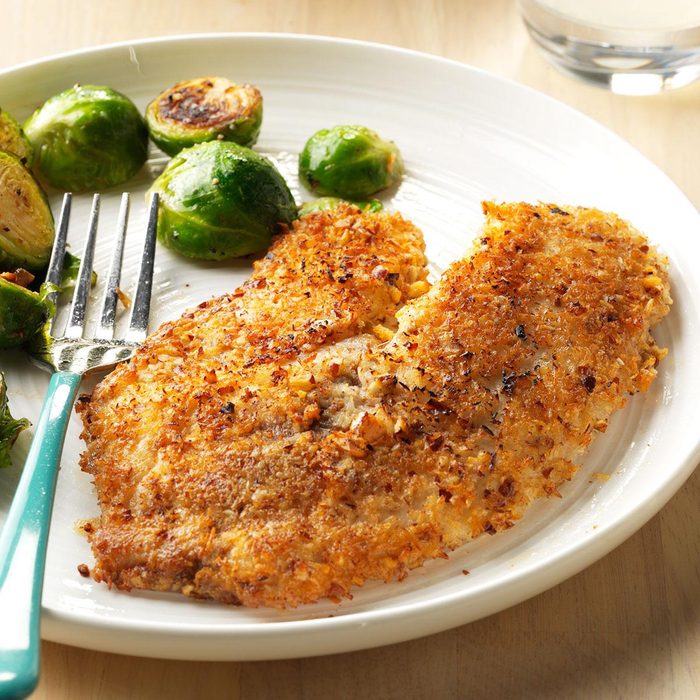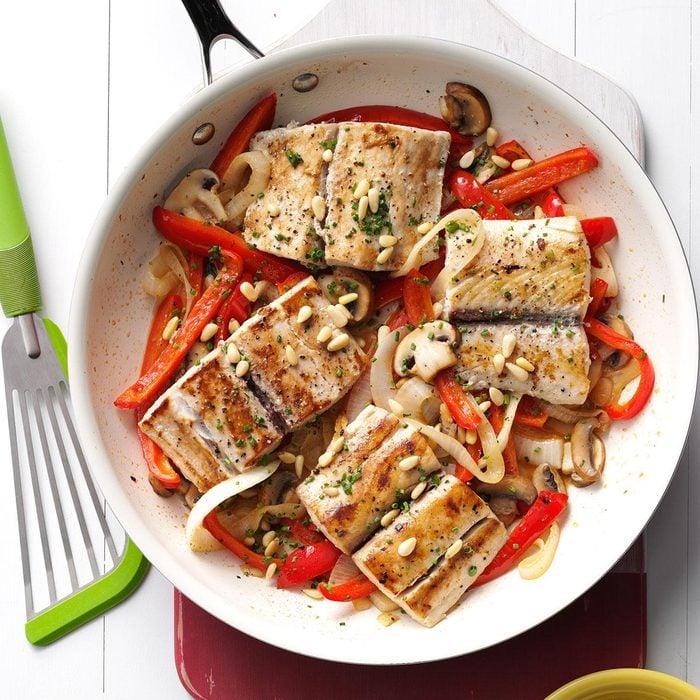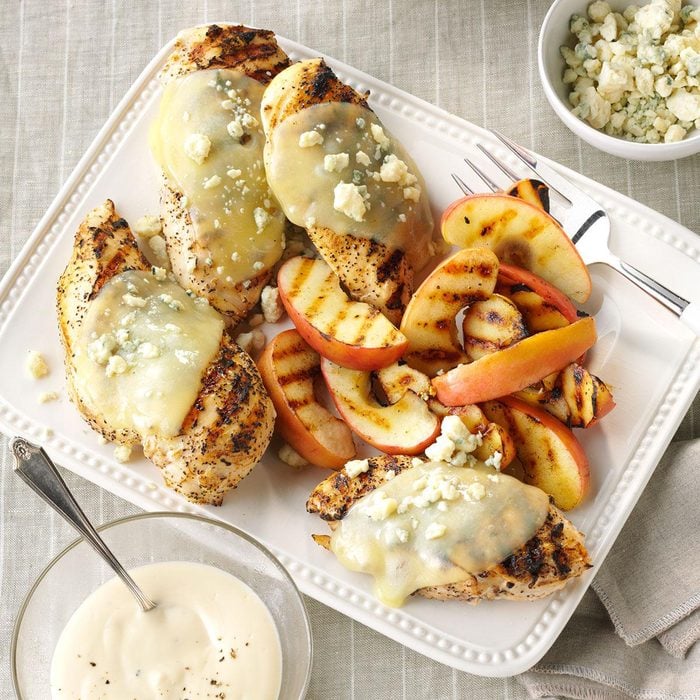Beef Suya
My Nigerian brother-in-law introduced me to beef suya, a very spicy street food that's popular in western Africa. I was intrigued when I found out the spice rub is made from ground peanuts and a blend of different seasonings. After lots of experimenting, I came up with my own version. —Elena Iorga, Irvine, California
Go to Recipe
Sheet-Pan Honey Mustard ChickenThis sheet-pan chicken is an easy gluten-free, low-carb meal ideal for busy weekdays. The chicken is tender, juicy and so delicious! It's now on the list of our favorite meals. You can substitute any low-carb vegetable for green beans. —Denise Browning, San Antonio, Texas. Plan your week ahead with this easy gluten-free meal plan.
Take a look at these delicious
gluten-free bread recipes.
Pressure-Cooker Salsa London BroilI love using my pressure cooker for this recipe—the dish comes together so quickly but still has that long, slow-cooked flavor. The veggies semi-melt into the sauce to give it an added savory taste and the lime gives it a pleasant finish. —Ann R Sheehy, Lawrence, Massachusetts
Cauliflower Tikka MasalaI'm a vegetarian, and it can be challenging to find new recipes. This cauliflower tikka masala is my easy take on the original. —Garima Arora, Charlotte, North Carolina
Grilled Summer Sausage SaladI love grilling vegetables, especially those straight from the garden. The summer sausage is a fun twist, and the veggies really get to shine in this main dish salad. Fresh garden herbs also taste great mixed into this salad. To amp up the flavor even more, try grilling romaine lettuce instead of using a salad mix. —Noelle Myers, Grand Forks, North Dakota
Chicken and Asparagus BundlesMy husband is a big asparagus fan, so I had to try this chicken-wrapped asparagus recipe. It's a mainstay when I want something unusual but simple for guests. For variety, you can leave off the sauce and serve the bundles chilled for lunch. —Donna Lohnes, Wooster, Ohio
Cajun Sirloin with Mushroom Leek SauceIn 30 minutes you‘ll have a restaurant-quality steak with a bold Cajun flair. The best part? You can skip the drive, the wait and the bill! —Joshua Keefer, Delaware, Ohio
Rotisserie-Style ChickenMy mother used to fix this rotisserie-style chicken when I lived at home, and we called it Church Chicken because Mom would put it in the oven Sunday morning before we left for church. When we got home, the aroma of the roasted chicken would hit us as we opened the door. —Brian Stevenson, Grand Rapids, Michigan
Pressure-Cooker Mexican Stuffed PeppersThese pressure-cooker stuffed peppers get a southwestern twist! The filling also makes a delicious meat loaf that we like cold as a sandwich with cheddar cheese, mayo and salsa. —Traci Wynne, Denver, Pennsylvania
Portobello and Chickpea Sheet-Pan SupperThis is a fantastic meatless dinner or an amazing side dish. It works well with a variety of sheet-pan-roasted vegetables. We enjoy using zucchini or squash in the summer, and you can also change up the herbs in the dressing. —Elisabeth Larsen, Pleasant Grove, Utah
Strawberry Tarragon Chicken SaladAfter thinking about creating this salad for some time, one spring I used my homegrown strawberries and fresh tarragon to do a little experimenting. It didn't take me very long to come up with a winner! My husband enjoyed my creation as much as I did, and now we can't wait for strawberry season to come around each year. —Sue Gronholz, Beaver Dam, Wisconsin
Jalapeno Popper Stuffed Chicken BreastsMy husband is not crazy about chicken, but one of his favorite snacks is jalapeno poppers. So I created this fast dinnertime recipe to give the chicken plenty of flavor. He loves it cooked this way, and best of all is the quick cooking with little cleanup! —Donna Gribbins, Shelbyville, Kentucky
One-Dish Ground Turkey Sweet Potato SkilletThis quick one-dish dinner helped keep my husband and me on track throughout the week while we were still learning to balance our busy schedules. — Shannon Barden, Alpharetta, Georgia
Caribbean Shrimp BowlAfter switching to a paleo diet a few years ago, we have started eating tons of veggies for almost every meal—yes, even breakfast. We’ve gotten used to swapping in cauliflower, broccoli and kale in place of carbs like rice or potatoes. This bowl is literally chock-full of veggies and has tons of Caribbean-inspired flavor! Plus, it is so simple to make and uses one skillet! —Courtney Stultz, Weir, Kansas
Chicken and Zucchini Foil PacksI enjoy foil-wrapped dinners cooked on the grill, especially because there are no pots or pans to wash. You can try making chicken foil packs with most fresh vegetables you have on hand. —Dianna Smith, Newport, Tennessee
Pressure-Cooker Southwestern Pork and Squash SoupI adapted a pork and squash stew recipe using tomatoes and southwestern-style seasonings. My husband and sons loved it, and the leftovers were even better the next day! Try it with fresh corn muffins. —Molly Andersen, Portland, Oregon
Goat Cheese and Spinach Stuffed ChickenThis spinach-stuffed chicken breast recipe is special to me because it has so much flavor, yet not too many calories. I love Italian food, but most of the time it is too heavy. This is a healthy twist on an Italian dish! —Nicole Stevens, Mount Pleasant, South Carolina
Egg-Topped Grilled Asparagus with Cajun ShrimpI make this dish whenever I feel as if I've been eating too many carbs. I love that it's easy, quick and low in calories. It's a tasty way to get myself back on track and eating healthier. If you don't have Parmesan on hand, any hard cheese will work with this meal. —Cheryl Green, Stanwood, Washington
Sausage Sweet Potato Sheet-Pan DinnerThis foolproof weeknight dinner is naturally gluten free, and is on your table in no time! It is easily adaptable and can be made using seasonal fruits or veggies. —Melissa Erdelac, Valparaiso, Indiana
Cocoa Spiced SalmonYou simply can't beat salmon from the Pacific Northwest waters. Family and friends go salmon fishing all the time and share their bounty. Inspired by the flavors of a Mexican mole, I came up with this blend for salmon and it is a perfect accent to this wonderful fish. —Ann Marie Eberhart, Gig Harbor, Washington
Sheet-Pan Chipotle-Lime Shrimp BakeI like to make this seafood dinner for company because it tastes amazing, but takes very little effort to throw together. Use asparagus, Broccolini or a mix of the two. It’s all about what's available for a decent price. —Colleen Delawder, Herndon, Virginia
Sesame Cilantro ShrimpOn days when I don't feel like spending much time in the kitchen, I reach for shrimp. I can have a hot meal in the table in 10 minutes. —Tami Penunuri, League City, Texas
Pronto Vegetarian PeppersIn the summer I love to serve these peppers with salad and a roll. At the end of summer, I freeze them for cold months when produce costs are high. For a hot meal on a cold day, I love to serve them with a side of warm pasta tossed in olive oil. —Renee Hollobaugh, Altoona, Pennsylvania
Gluten-Free Chili Beef PastaAfter I got married, my aunt gave me her recipe for skillet spaghetti and told me it was ideal for a quick weeknight meal. Over the years I’ve tinkered with the ingredients and played with the seasonings to make it healthier. It's a dish my family truly loves. —Kristen Killian, Depew, New York
Chicken and Falafel WafflesThese gluten-free waffles made from garbanzo beans perfectly complement Moroccan-spiced chicken with cucumber relish. They're a savory, low-carb spin on a classic comfort dish. —Arlene Erlbach, Morton Grove, Illinois
Spicy Coconut Shrimp with QuinoaHelp yourself to a plate full—generous servings are still lower in calories and big on protein. If you have company, you can add a salad and call it a day. —Keri Whitney, Castro Valley, California
Southern Pork & RiceAt our house, we're big on healthy eating. These ultra tender chops with colorful rice and black-eyed peas are a meal fancy enough for a dinner party. —Annie Holmes, Murfreesboro, Tennessee
Pineapple Shrimp Fried RiceMy husband often ordered pineapple fried rice at Thai restaurants, so I surprised him by tweaking some similar recipes to come up with a version that's both simple and delicious. —Bonnie Brien, Pacific Grove, California
Pancetta and Mushroom-Stuffed Chicken BreastI was inspired by a stuffed chicken Marsala dish I had at a restaurant and wanted to come up with my own version using a different flavor profile. —Ashley Laymon, Lititz, Pennsylvania
Green Curry Salmon with Green BeansLike a lot of people here in the beautiful Pacific Northwest, my boyfriend, Michael, loves to fish. When we have an abundance of fresh salmon on hand, this is one way we cook it. —Amy Paul Maynard, Albany, Oregon
Spiced Grilled Chicken with Cilantro Lime ButterThis grilled chicken gets a lovely pop of color and flavor from the lime butter—don't skip it! —Diane Halferty, Corpus Christi, Texas
Lettuce-Wrap BurgersThese fresh flavors blend like a dream. It's a snap to throw the wraps together for a quick, healthy lunch. The burgers can also be served on buns if you like. —Rachelle McCalla, Atlantic, Iowa
Sheet-Pan Shrimp FajitasI love easy weeknight dinners such as this one. The sheet-pan shrimp fajitas come together so quickly and are customizable with your favorite toppings. —Carla Hubl, Hastings, Nebraska
Zucchini Pizza CasseroleMy husband has a hearty appetite, our two kids never tire of pizza and I grow lots of zucchini, so this tasty tomato casserole is absolutely tops with us throughout the entire year. Once you've tried the recipe, you may even decide to grow more zucchini in your own garden next summer! —Lynn Bernstetter, White Bear Lake, Minnesota
Vegetable, Steak and EggsLow-carb doesn't have to mean skimpy—here's a lighter take on steak and eggs. I love cooking with squash, but feel free to toss in any vegetable combination you like. —Robert Deskin, Plantation, Florida
Sausage Potato SupperOne Saturday night a few years ago, I came up with this dish on the spur of the moment. It was dinnertime, and I had to use what I had on hand. It's been a hit with my family ever since. —Nancy Russell, Englewood, Colorado
Chicken ProvoloneChicken Provolone, though one of my simplest dishes, is one of my husband’s favorites. It is easy to prepare and looks fancy served on a dark plate with a garnish of fresh parsley or basil. Add some buttered noodles for an easy side dish. —Dawn Bryant, Thedford, Nebraska
West African ShrimpMy girls have always loved seafood, so I invented a shrimp dish with coconut milk and ginger. They raved; I was delighted. It's great with jasmine rice. —Sharon Scaletta, Johnstown, Pennsylvania
Grilled Brown Sugar-Mustard ChickenI came up with this recipe in college and it's been a household staple ever since. It's a snap to throw together with ingredients I have on hand. —Kendra Doss, Colorado Springs, Colorado
Asparagus Turkey Stir-FryWhen people try this dish, they ask for the recipe, just as I did when I first tasted it when visiting a friend's home. Tossed in a delicious lemon sauce, this simple skillet dish is sure to satisfy on the busiest of nights. It's a great way to use leftover turkey. —May Evans, Corinth, Kentucky
BLT Chicken SaladFeaturing all the fun fixings for a BLT chicken sandwich, this salad is so lovable. I can prep the ingredients ahead of time and just throw it together at the last minute. Barbecue sauce in the dressing gives it unexpected flavor. Even picky eaters love my chicken salads. —Cindy Moore, Mooresville, North Carolina
Herbed Pork ChopsHerbs are a fast and flavorful way to dress up pork. Plus, they make the chops look so pretty on a platter. I prepare these year-round as a way to capture the taste of summer. —Dianne Esposite, New Middletown, Ohio
Zippy Turkey ZoodlesEating healthy doesn't mean sacrificing flavor—and these spiced-up zoodles prove it. If you don't have a spiralizer, simply slice the zucchini julienne-style. —Elizabeth Bramkamp, Gig Harbor, Washington
Quick & Easy New Orleans ShrimpI’ve simplified my mom's Shrimp Creole—she made it for us growing up. Now it's effortless comfort food I make for my own family. —Crystal Milne, Urbana, Illinois
Lemon-Pepper Tilapia with MushroomsMy husband and I are trying to add more fish and healthy entrees to our diet and this one makes it easy. It comes together in less than 30 minutes, so it's perfect for hectic weeknights. —Donna McDonald, Lake Elsinore, California
Enchilada ChickenWe enjoy ethnic dishes and this is tasty and healthy!
Chicken Thighs with Shallots & SpinachWhat could be better than an entree that comes with its own creamy vegetable side? This healthy supper goes together in no time flat and makes an eye-catching presentation. —Genna Johannes, Wrightstown, Wisconsin
Shrimp & Feta SkilletMy friend’s feisty Italian grandmother, Gemma, makes a dish similar to my shrimp with tomatoes. When I make this recipe, I think of Gemma and smile while stirring. —Celeste Ehrenberg, Topeka, Kansas
Chicken & Garlic with Fresh HerbsThe key to this savory chicken is the combination of garlic, fresh rosemary and thyme. I like to serve it with mashed potatoes or crusty Italian bread. —Jan Valdez, Lombard, Illinois
Scallops with Wilted SpinachTwo of my favorite foods are bacon and seafood. In this dish, I get them together with white wine, shallots and baby spinach. Serve with bread to soak up the tasty broth. —Deborah Williams, Peoria, Arizona
Pecan-Coconut Crusted TilapiaWhen I have guests with dietary restrictions, tilapia coated in pecans and coconut makes everyone happy. It's gluten-free and loaded with flavor. —Caitlin Roth, Chicago, Illinois
Mahi Mahi & Veggie SkilletCooking mahi mahi with a mix of vegetables may seem complex, but I developed this skillet recipe to bring out the wow factor without the hassle and fuss. —Solomon Wang, Arlington, Texas
Dilly Barbecued TurkeyThis is one of my brother-in-law's special cookout recipes. The onions, garlic and herbs in the marinade make a tasty, tender turkey, and the tempting aroma prompts the family to gather around the grill.
—Sue Walker, Greentown, Indiana
Chicken Alfredo with Grilled ApplesIf you've never grilled apples before, here's your excuse to start. I created this Alfredo-style chicken for a party. By the number of recipe requests, I knew it was a hit. —Richard Robinson, Park Forest, Illinois
Slow-Cooked Pork Roast DinnerThis delicious recipe will give you the most tender pork you have ever tasted! You can cut it with a fork, and it's just as moist and tender the next day—if there are any leftovers. —Jane Montgomery, Piqua, Ohio
Up Next: The Best Gluten-Free Recipe from Every State
